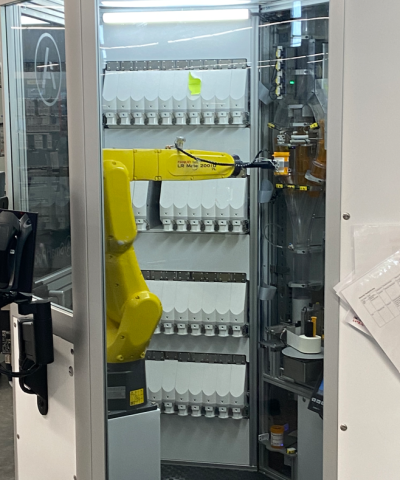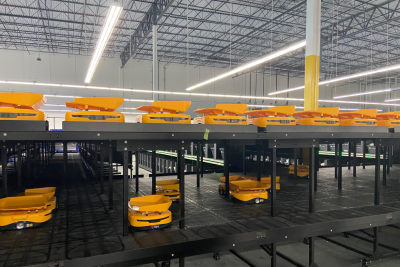CHICAGO—Despite a recent leadership shake-up and subpar third-quarter financial results, Walgreens’ executives maintain that its transformation from a retail store to a full-blown healthcare company is the correct long-term strategy.
In a bid to expand its brand image, Walgreens has utilized its relationship with VillageMD, which is majority-owned by Walgreens Boots Alliance, to wade further into the provider space, purchasing medical practice Summit Health for $9 billion in November and entering into a strategic partnership with value-based care Pearl Health earlier this month. The pharmacy giant hopes to be a one-stop shop for customers looking for primary care and easy pickup of prescription drugs, though it has run into trouble in recent months and has also experienced the abrupt departure of CEO Rosalind Brewer.
She will be replaced by interim CEO Ginger Graham, marking a strategic shift away from Brewer’s retail background that she cultivated during her time at Walmart, Sam’s Club and Starbucks. And while sales were up nearly 9% last quarter, Walgreens slashed its profit outlook for the remainder of the year. Wall Street has noticed, with Walgreens Boots Alliance’s stock near a year low down 41%.
Still, Walgreens’ higher-ups say its healthcare segment, which includes specialty pharmacy Shields Health and Care Centrix, a post-acute and home care provider, is on the right path.
“Understanding that healthcare is broken and we can help fix it is what pulls all this together,” said John Driscoll, executive vice president and president of U.S. healthcare for Walgreens Boots Alliance, to reporters during a tour of the company’s facilities.
“There’s no one who has any idea what healthcare economics will absolutely look like five or 10 years from now,” said Clive Fields, M.D., co-founder of VillageMD. “We believe this model will ultimately be best suited to meet whatever comes down that road.”
RELATED
More Walgreens coverage from Fierce Healthcare
The VillageMD gamble
At the heart of Walgreens’ plan is to create an environment where pharmacists and medical professionals can best support their communities, leaders said Sep. 20. In theory, that will lead to better patient outcomes at a lower cost.
Of 800 clinical Village Medical locations, around 220 sites are co-located within a Walgreens pharmacy store and are up to 5,000 square feet. These are primary care operations, not acute care delivery, and are meant to fill a void in communities around the country, executives said.
“What we’re looking for is populations with chronic diseases,” said Fields. About 40% of stores are located in areas underserved by primary care, while the group accepts customers with Medicare and Medicaid or commercial plans along with the uninsured.
Each primary care location includes a waiting room with oversized chairs, TVs showing educational content and skylight artwork. Chicago’s first joint Walgreens-VillageMD site, which reporters were invited to tour, opened in August in Elk Grove Village, Illinois. Executives said all offices are virtually identical, no matter what neighborhood the store is in. It includes eight exam rooms and a full-service lab with equipment available for everything from EKGs to COVID-19 tests to a fridge of vaccines commonly needed for children and adults.
Patient rooms were designed to be bigger and include more color and fewer 90-degree edges than an average doctor’s office, scales (since patients don’t like the lack of privacy when they are traditionally placed in hallways, said Fields), sliding soundproof barn doors and informational screens helping physicians stay up to date regarding which patients are in each room. All these accommodations were made to help a customer feel more comfortable.
Fields said that in 2019, when this category of healthcare delivery was far less prominent, the strategy of transitioning from acute care to providing primary care garnered a lot of skepticism from critics who said customers wouldn’t want to see a doctor at Walgreens, and no doctor would want to work at Walgreens. He said that perception is changing, due to valuing “private, privileged and professional” locations.
“We attract primary care doctors … because they want to be broad in focus,” he said. “The VillageMD model really meets the needs of people who are getting out of medical school or residency.” He added that physicians at Walgreens can now synchronize medicines regardless of when a prescription is written, allowing patients to pick up orders in bulk and helping reduce administrative backlog in a physician’s electronic medical record inbox.
Rina Shah, senior vice president, pharmacy of the future and transformation for Walgreens, said she foresees Walgreens “investing heavily” to free up capacity for pharmacists so they can spend more time with their patients.
That is done, in part, due to centralized call center services, which direct 1.2 billion annual calls to Walgreens pharmacies. This serves two purposes: to not disrupt pharmacists with phone calls each day and to better provide callers with the services they need. She said 75% of all calls to their pharmacies are solved digitally.
“You can't have an incredible experience coming through VillageMD, and then come here and wait in line for 10 or 20 minutes to get the care you need,” she explained.
Not all VillageMD locations are located within a Walgreens retail store. Driscoll declined to say which markets the two parties might want to expand into next, or which in markets the model has proven unsuccessful, only to say they will continue expanding in key markets when it makes sense.
“VillageMD is the most important piece [to Walgreens’ plan],” said Driscoll. “It’s our biggest bet because it’s the biggest opportunity we have to change healthcare in a very integrated way at scale.”
Serving the ‘entire’ supply chain
In Bolingbrook, Illinois, one micro-fulfillment center with 400 employees, comprised mostly of technicians and pharmacists, processes orders for 646 stores throughout Illinois, Iowa and Wisconsin. The center is one of 11 nationally, though Walgreens intends to open eight more in the next year.
The center is nearly a year old and is responsible for all sorting and labeling of prescription orders at a patient level for routine maintenance medications, such as drugs treating high blood pressure or heart disease. Often, deliveries can arrive within one day. More than 50,000 orders can be processed each day.
The floor is divided into stations. Automated fulfillment makes up 75% of all orders processed at the facility. Robots extend their arms to select pills from canisters, fill bottles, close the caps and send the order on to the next stage of the process. This is repeated 300 times per robot each hour. More complicated orders that involve two or more prescriptions for one customer, or collating, goes to a different station. Collating accounts for 30% of the total volume at the facility.

Manual filling stations, where 90 to 100 prescriptions can be completed in an hour, are essential for instances when automated robots can’t scan an order or due to other safety reasons.
Toward of the back of the warehouse is a collection of robotic cars, or sorters, that take prescription bags to totes. These totes are sorted and labeled for store delivery. Zooming around a multiple-level platform divided into 10 stations, the sorters can transport up to 8,000 prescription bags an hour. Totes are shipped out multiple times a day through a partnership with distributor AmerisourceBergen.
The Bolingbrook location could be utilized further, said Scott Malone, vice president for pharmacy engagement experience at Walgreens, during the tour. Underused storage space could eventually include processing for over-the-counter products for home delivery, but no timetable for this additional processing was shared with reporters.
Walgreens expects 19 facilities will be able to serve more than 8,000 pharmacies by the end of next year, equivalent to “nearly the entire chain.”
When pressed on whether the reliance on automation will eliminate the need for pharmacists, Walgreens executives said robotics at its fulfillment center is just another example of the company attempting to relieve pharmacists from uninspiring tasks, leaving time for more enjoyable, intellectual tasks. They said the goal is not less work but better work.

“Pharmacists are trained to do so much more than just fill a prescription,” said Shah, acknowledging that a normal day in the life of a pharmacist can be a rude awakening for recent graduates. “The technology has advanced, but the industry hasn’t embraced it.”
She hopes that pharmacist shortages plaguing the industry might eventually subside once students see that job responsibilities have changed.
“The environment from 10 years ago is not what they want to work in,” she added. Notably, former CEO Brewer said in an investor’s call this year that the company did not plan on raising base wages for pharmacy technicians from $15 an hour, saying the staffing shortage was less extreme than before, reports Becker’s Hospital Review.
It remains to be seen whether these innovations will change Walgreens’ financial trajectory. Driscoll said he wouldn’t project financial expectations before the next earnings call but noted that the investment stage the company finds itself in “won’t go on forever.”